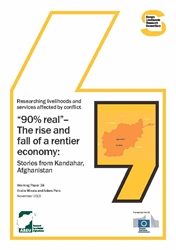
11 Nov “90% realâ€â€“ The rise and fall of a rentier economy: Stories from Kandahar, Afghanistan
Posted at 07:24h
in Uncategorized
Back Highlights
| Authors | Giulia Minoia, Adam Pain |
|---|---|
| Type | Working Paper |
| Theme | Social Protection and Livelihoods |
| Language | English |
| Date of Publication | November 11, 2015 |
| Total Pages | 32 |
| Available In | English |
| Description |
This ethnographic study started as an enquiry into the employment opportunities rural migrants have found on the informal margins of Kandahar’’s urban economy. It broadened into a more general investigation into the rise and fall of the city’’s economy since 2001, including interviews with businessmen and others familiar with the reconstruction boom the city experienced.
The study in the informal sector focused on three sub-sectors of the street vendor economy: the selling of tarpaulins, clothes and mobile phones. It found that many of those who had secured a foothold in it were migrants from Kandahar’’s rural districts, and they were often landless, driven out by insecurity and a lack of employment owing to drought. They had also been pulled into the city at a time when prospects were better. They found the entry barriers to becoming a street vendor were relatively low and relationships of solidarity enabled access and in many cases direct provision of starting capital. Initially, in the boom years, being a street vendor provided a significantly better living than people had had before. But now times are harder, insecurity is greater and there has been a general economic downturn. In addition, people face major risks as a result of the actions of the police and municipal authorities in the city. The police see vendors as a potential security threat and the municipality treats them as illegal. Steps are being taken to regulate their presence but this will not secure better economic prospects. |

